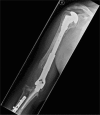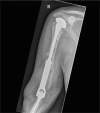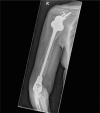Intramedullary humeral replacement: an evolving design
- PMID: 27163092
- PMCID: PMC4849264
- DOI: 10.1051/sicotj/2015045
Intramedullary humeral replacement: an evolving design
Abstract
Introduction: Total humeral replacement is used to reconstruct the upper limb after tumour resection, while in cases of complex revisions for non-oncological reasons, using tumour prosthesis implants will lead to an otherwise avoidable further bone resection and violation of the surrounding tissues. This report describes a design evolution in three non-oncological cases, where a total humeral resection to perform a total humeral replacement is avoided and instead the simultaneous shoulder and elbow replacements were connected via custom-made intramedullary linkages.
Methods: Three cases of simultaneous shoulder and elbow replacement were performed for complex revision situations over a period of 42 months. They were performed while preserving as much humeral bone stock as possible, with the design changing from a big intramedullary connecting stem to a smaller component when performing an Intramedullary Humeral Replacement (IMHR), allowing preservation of more bone and soft tissue attachment than if a total humeral replacement were performed.
Results: None had any neurovascular complication or any further revision for the humeral replacement, or the shoulder and elbow components.
Discussion: We have showed three examples of an evolving design aiming to preserve as much of the anatomy as possible to help in decreasing the surgical impact and invasiveness of this procedure, while doing less bone resection and sacrificing less of the soft tissue attachments.
Keywords: Elbow replacement; Endo-prosthetic replacement; Humeral replacement; Megaprosthesis; Shoulder replacement.
Figures









References
-
- Puri A, Gulia A (2012) The results of total humeral replacement following excision for primary bone tumour. J Bone Joint Surg [Br] 94-B, 1277–1281. - PubMed
-
- Simon MA, Aschilman MA, Thomas N, Mankin HJ (1986) Limb-salvage treatment versus amputation for osteosarcoma of the distal end of femur. J Bone Joint Surg [AM] 68(9), 1331–1337. - PubMed
LinkOut - more resources
Full Text Sources
Other Literature Sources
